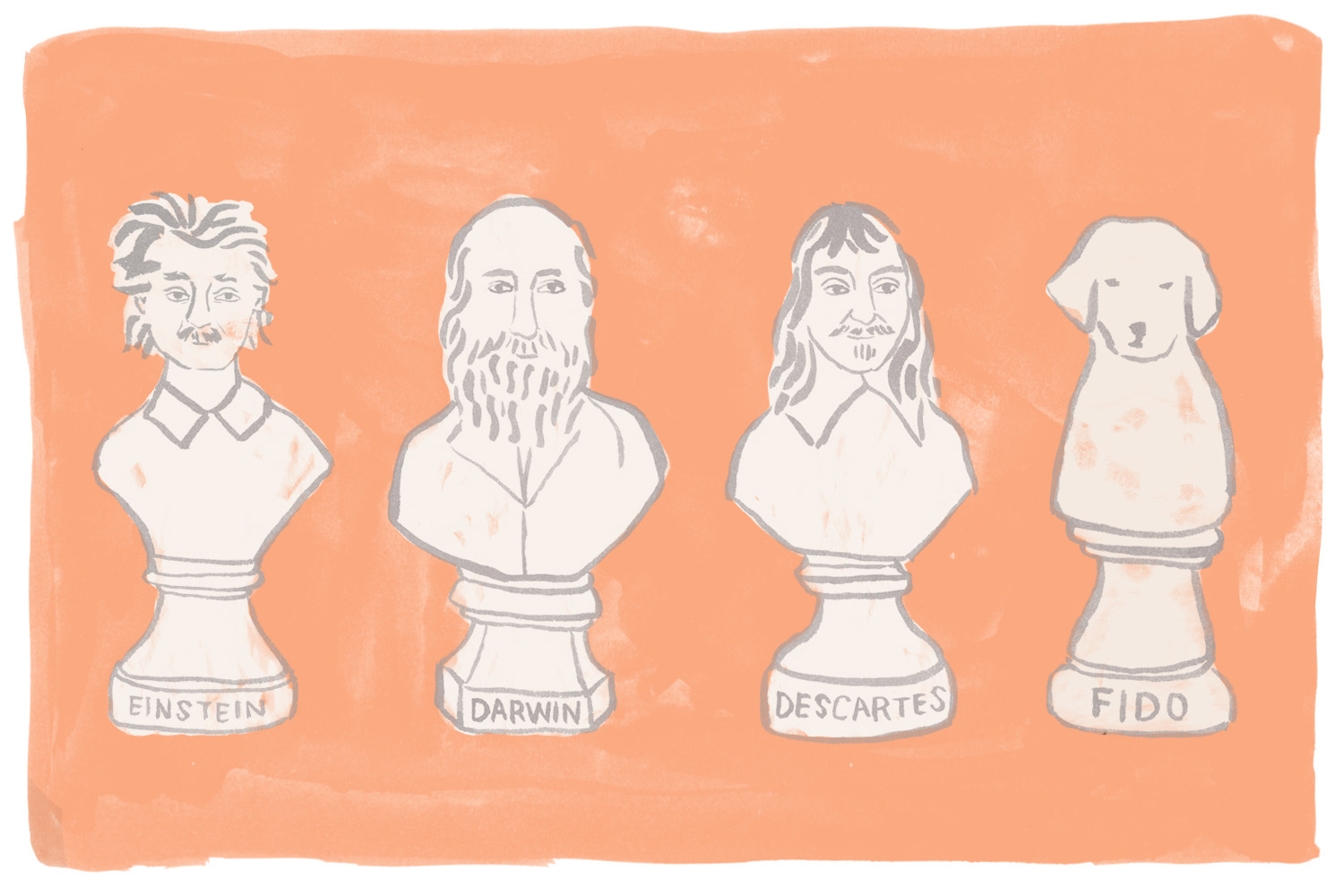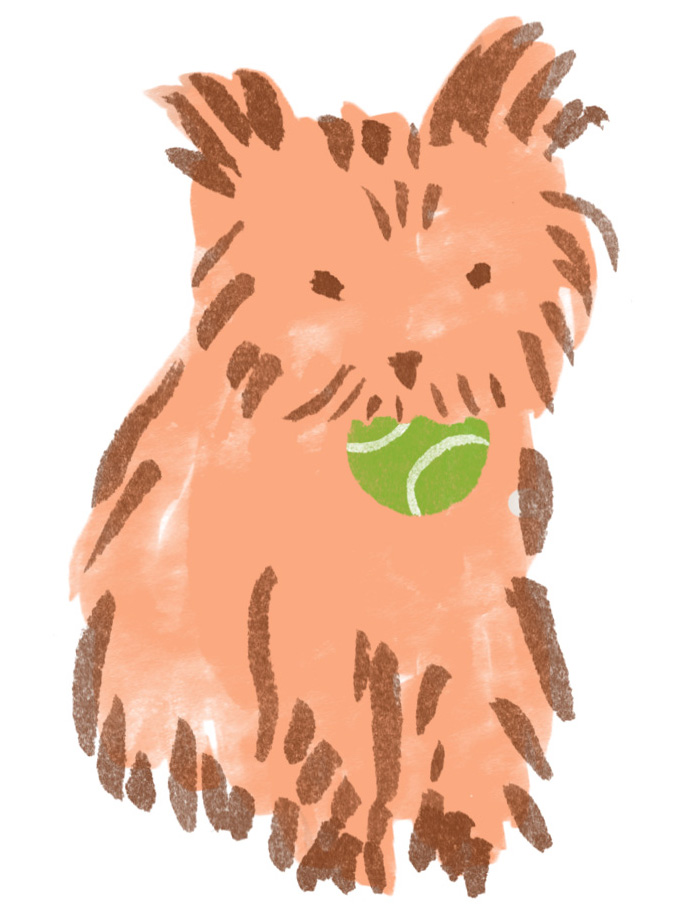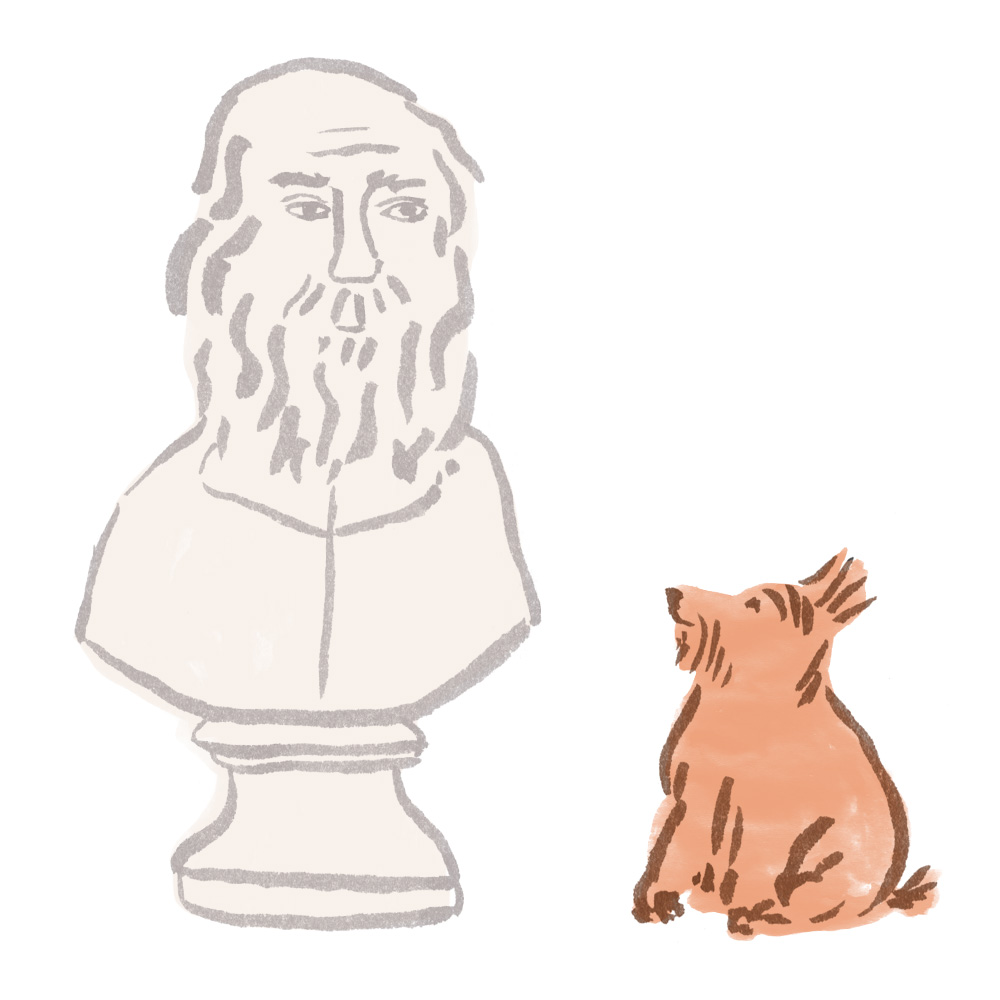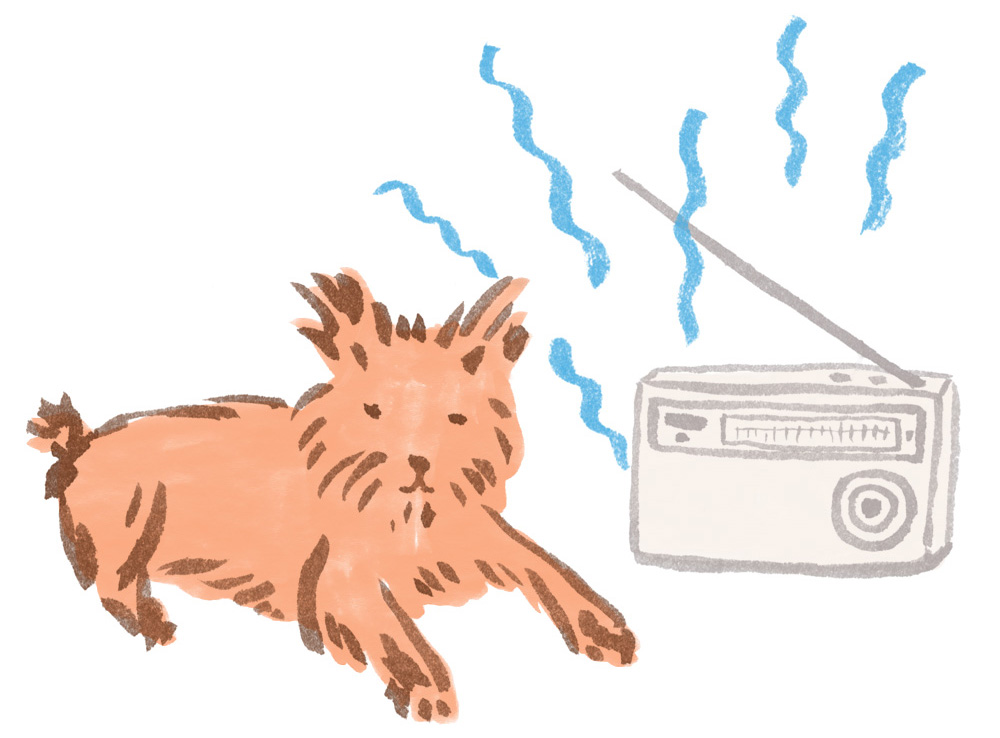
The Duke Canine Cognition Center is one of the world’s most prestigious dog laboratories, but you’d never know it from the looks. Located at Duke University in Durham, North Carolina, it’s just three small rooms in the subbasement of the school’s Biological Sciences Building, a faded red-brick structure that stands in a clump of similarly nondescript buildings on the west end of campus. My tour of the facility — a modest lounge, a barren rectangular room, and a narrow alcove filled with cabinets — took all of about thirty seconds. It turns out you don’t need much to probe the secrets of the dog’s mind.
I had come here to witness the final stage in the transformation of our pets from wild animals into family members. Dogs and cats may have entered our homes, but there’s still so much we don’t know about them. Are they as smart as we think? Do they love us as much as we love them? We can’t truly accept these creatures as family until we can glimpse what’s going on in their heads.
'If human beings were as smart as animals,' the driver told me, 'we’d be a lot better off.'
I’d actually gotten my first peek at the canine intellect a day earlier. I had arrived in the middle of a triple-digit heat wave, and the driver of the mercifully air-conditioned shuttle that picked me up from the airport asked why I was in town. “I’m going to visit a scientist who studies dogs,” I told the man, a pale gentleman in his early seventies who spoke with a mellow southern accent. Then, guessing a bit, I added, “He’s trying to figure out if dogs are smarter than we thought.” The driver laughed. “Heck, of course they’re smart,” he said. “They’re smarter than us!”
As the van plowed along a highway that cut through a dense forest of pine trees, the driver told me about Shadow, a four-year-old Siberian husky he’d adopted from a local shelter. The dog, he said, was a regular canine Einstein. “When I go to bed, I look at him and say, ‘Shadow, seven o’clock. Shadow, seven o’clock.’ And sure enough, at seven in the morning he barks until I wake up. I don’t need an alarm clock!” Shadow, the man claimed, could also ring his doorbell and open the sliding glass doors of his boat. He understood more than 30 words and kept track of his owner’s schedule. “When I put my suitcase by the front door, he knows I’m going away for a couple of days, and he just sits at the door and sulks.” The dog even knew when he’d done something wrong; when he knocked a plant over or whizzed on the carpet, he turned his head and looked away in guilt. “If human beings were as smart as animals,” the driver told me, “we’d be a lot better off.”
After my visit to Duke, I realize he was a lot closer to the truth than he knew.
Canine Einsteins
When I arrive at the Duke Canine Cognition Center, the man I’m here to see isn’t around. Brian Hare, the biological anthropologist who runs the lab, is sprinting across campus with a cooler full of what he later told me was the “world’s largest collection of bonobo pee,” scrambling to find dry ice so he could ship the samples to a colleague. Fortunately, three of his graduate students are around, and they volunteer to show me some of their work. They lead me to an empty room, a 10-by-16-foot space with a white tile floor that looks like it has been vandalized by a geometry teacher. Multicolored tape decorates the ground in a variety of shapes and patterns: green brackets float near yellow squares; long red lines balance on red triangles. The students tell me the tape designates places where researchers are supposed to sit or where equipment is supposed to stand. The markings ensure that each experiment is replicated precisely.
As the grads begin to move some chairs into the space, something brown whizzes past my ankles. I’ve just caught a glimpse of Napoleon, a three-year-old, seven-pound Yorkshire terrier whose glossy tan head and legs flash out from a jet-black body. He’s chasing a pint-sized tennis ball, tornadoing around the room and jumping onto the legs and crotch of anyone who crosses his path. The dog belongs to one of the students, Evan MacLean, an athletic 30-year-old who informs me that the tiny dynamo will be our test subject for the day. My eyes widen. I have a hard time believing that Napoleon can sit still, much less participate in a scientific experiment. But when the tests begin, he becomes as serious as a college student during final exams.
If you want to know how human intelligence evolved, they said, ask a chimp. Maybe a dolphin or elephant. But never a dog.
The first experiment doesn’t seem like an experiment at all. MacLean walks to one side of the room, stands on a stripe of blue tape, and lobs the mini tennis ball toward the opposite wall. Napoleon darts after it, grabs it in his mouth, and scurries back to MacLean, who has turned his back to the dog. Napoleon walks around to MacLean’s front side and deposits the ball. “Good job, Polli!” he says.

Napoleon has just passed a test related to having a theory of mind. That’s the ability to intuit how others see the world and even, to some extent, know what they’re thinking. Humans develop a more complex form of this ability at about four years of age. In a classic test of developmental psychology, a researcher shows a child where a toy is hidden while his mother is out of the room. When the mother returns, the scientist asks the youngster if his mom knows where the toy is. If the child says yes, he hasn’t developed a theory of mind, because he assumes his mother knows the same things he does. If he says no, he has the skill; he realizes his mother’s knowledge is different from his own.
What Napoleon did wasn’t quite that sophisticated. By dropping the ball in front of MacLean, he demonstrated that he knew where his owner’s attention was focused, which is not quite the same as knowing what MacLean was thinking. Had he released the ball behind MacLean, however, it would be a pretty safe bet that the dog had zero theory of mind. Chimpanzees pass a similar test. Place two chimps in a room with a plate of grapes, and the chimp lower on the social totem pole won’t grab one until the higher-ranking chimp looks away. The animals also clap their hands and make raspberry noises with their lips when they want to get the attention of a researcher who isn’t watching them.
In the next experiment, however, Napoleon does something chimps can’t do. MacLean stands near a wall with the dog on a slack leash, while a female graduate student sits on a chair in the center of the room. She sets two opaque red cups upside down on the floor, one on each side of her. Then, as Napoleon watches intently, a third graduate student enters the room. She places the dog’s tennis ball under one of the cups and pretends to place it under the other, obscuring her motions with a small black board so the terrier isn’t sure which cup contains the ball. If this were a shell game, the dog would have a fifty-fifty shot of picking the right cup. But the seated graduate student gives him a hand, or, more precisely, a finger. She points to the cup on her right, and when MacLean lets go of the leash, Napoleon runs over to it and retrieves his ball. Over several trials, the dog always goes for the cup that is pointed out. Even when the seated student merely gazes at the correct cup, Napoleon gets the message.
This may seem like a simple test, and, indeed, even one-year-old children pass it. But our closest relatives, chimpanzees, fail miserably. They ignore the human helper, pick cups at random, and rarely score above chance. Brian Hare’s lab has become famous for spotting this difference. Napoleon has performed more than just a neat cognitive trick. He has displayed a more complex skill related to the development of theory of mind in children. He wasn’t just clued into the pointing student’s attention; he had shown behavior consistent with understanding her intention. He showed that he realized that the student wanted to show him something, that she had a desire.
When Brian Hare finally arrives at the lab about an hour later, he’s still pumped up from his cross-campus quest to cool bonobo pee. That energy has served him well. In his late thirties, Hare rarely stays put, dividing his year between dogs and lemurs at Duke, baboons at the North Carolina Zoo, and chimpanzees on an island in Uganda. And, of course, there are the urinating bonobos, which live in a sanctuary in the Democratic Republic of Congo. Since I visited, he’s also become the cofounder and chief science officer of Dognition, an online research project and business venture designed to help owners probe their dog’s mental abilities.
Hare tells me he got into studying dogs by accident. He was an undergraduate at Emory University in Atlanta in the late 1990s, exploring the cognitive differences between chimps and toddlers. When he conducted a few pointing tests, he and his advisor, Michael Tomasello, were shocked to learn that toddlers had no trouble understanding what a researcher meant when he pointed to a cup, but chimps were totally perplexed. Tomasello concluded that the ability to follow pointing cues was so advanced it must have only evolved in humans.
“But I told Mike, ‘Um, I think my dog can do that,’” Hare says. “And that’s how it all started.” Back then, almost no one was studying dogs. All those thousands of years of domestication, the thinking went, had corrupted them, at least from a scientific standpoint. Because they were no longer wild animals, researchers considered them artificial and of limited value. If you want to know how human intelligence evolved, they said, ask a chimp. Maybe a dolphin or elephant. But never a dog.
Ironically, however, the history of animal cognition research begins with dogs. And perhaps not surprisingly, it also begins with Charles Darwin.
Darwin’s Dogs
Darwin came along during a time when animals, thanks largely to the writings of French philosopher René Descartes, were viewed as reflex-driven machines with nary a mind in their heads. Everything an animal did, every decision it made, was chalked up to instinct. Only humans possessed true intelligence.

Darwin didn’t buy it. Perhaps it was because he had spent so much of his life with canines. In her revealing book Darwin’s Dogs, British journalist Emma Townshend writes that the famed naturalist came from a family of dog lovers, and Darwin himself was no exception. He owned at least 13 throughout his life, including a black-and-white mutt named Spark — a childhood companion he fondly referred to as “little black nose” — and a white terrier, Polly, who slept in a pillowed basket near the fireplace as Darwin inked one of his final books, The Expression of the Emotions in Man and Animals, in which Polly appears frequently. (Darwin, incidentally, was not a cat person, though as his daughter Henrietta wrote, “He knew and remembered the individualities of my many cats, and would talk about the habits and characters of the more remarkable ones years after they had died.”)
Darwin appears to have first begun thinking about the mental capabilities of dogs when he should have had something far more important on his mind. It was early October 1836, and he had just returned from his five-year voyage on the HMS Beagle, a ship that had ferried him to the Galápagos Islands. The variety of finches and tortoises there would eventually help inspire his theory of evolution, but upon arriving home to Shrewsbury in western England, Darwin’s first scientific thought turned to dogs. He wondered whether one of his canines, vicious to everyone else, would remember him. “I went near the stable where he lived, and shouted to him in my old manner,” Darwin wrote. “[He] instantly followed me out walking, and obeyed me, exactly as if I had parted with him only an hour before.” The experience was clear evidence to Darwin that dogs had long memories — and serious intellects.
In later years, Darwin would postulate that dogs were capable of abstract thought, morality, and even language. Dogs, he wrote, understood human words and sentences, and they responded with barks of eagerness, joy, and despair. If this wasn’t communication between the species, what was? The observations affirmed his notions that humans were not unique in having complex minds. “There is no fundamental difference between man and the higher animals in their mental faculties,” he wrote.
Darwin’s close friend and research associate, George Romanes, took that idea and ran with it — some say a bit too far. A Canadian-born biologist 40 years Darwin’s junior, Romanes also glorified the minds of dogs. He related stories of how they could sniff out someone’s social status, play tricks on people, and even understand the value of money. “My friend was acquainted with a small mongrel dog,” Romanes wrote, “who on being presented with a penny or a halfpenny would run with it in his mouth to a baker’s…. The dog would accept any small biscuit for a halfpenny, but nothing less than a bun would satisfy him for a penny.” The wealth of anecdotes convinced Romanes there was practically no difference between the animal brain and the human one.
'The dog would accept any small biscuit for a halfpenny, but nothing less than a bun would satisfy him for a penny.'
Stories were one thing. But the first real research into the minds of dogs didn’t begin until 1884, when an English banker named John Lubbock, who dabbled in the sciences, published the earliest study on language ability in a nonhuman. That nonhuman was a poodle named Van. Lubbock taught the dog to distinguish between blank pieces of cardboard and those with the words “Food,” “Tea,” “Water,” “Bone,” and “Out” written on them. Left to his own devices, Van fetched the “Food” and “Tea” cards far more frequently than the other cards, and since tea was one of the canine’s favorite treats, the banker concluded that the dog had learned to communicate with him. Van, “the Talking Dog,” became an international celebrity, and in a clear rejection of Descartes, Lubbock wrote, “No one, indeed, I think, who has kept and studied pets… can bring himself to regard them as mere machines.”
The views of Lubbock and Romanes, however, fell out of favor for many years, replaced by behaviorism — a school of thought that would rule the field of psychology for much of the 20th century. Behaviorists essentially said that scientists should focus only on what they could observe, not on the intangibles inside a creature’s head.
Not until the 1970s did an American zoologist named Donald Griffin challenge the behaviorist dogma. Griffin had made his name discovering that bats could navigate by bouncing ultrasonic signals off objects, a sonar-like ability he termed “echolocation.” But late in his career, he turned his attention to what he felt was a far more extraordinary ability: animals’ capacity to think and reason. Lubbock and Romanes were back, but this time they had hard science on their side. In a series of articles and books, Griffin highlighted new techniques and cutting-edge fieldwork that were showing, for example, that monkeys used deception in their alarm calls and that crows could fashion tools out of twigs. His ideas sparked a scientific revolution and a new approach to studying animal minds, which he dubbed “cognitive ethology.”
Chimps Get Outfoxed
But what about dogs? The old biases — that they were artificial, that they had been corrupted by domestication — still held. Then, two things happened at around the same time. Brian Hare told his advisor that he thought dogs could best chimps at the pointing test, and a Budapest researcher named Ádám Miklósi was told by his advisor to stop studying fish and start studying dogs. Inspired by the antics of his mutt, Flip, the advisor wanted Miklósi to figure out why canines were so smart. Unaware of each other’s research, Miklósi and Hare both published work showing that dogs could understand human pointing in 1998. Over the next decade, nearly a dozen labs, from Berkeley to Yale, Kentucky to Austria, began studying the canine mind. The canine revolution had begun.
When Brian Hare opened the Duke Canine Cognition Center in 2009, he worried about getting enough dogs for his studies. Instead, he had the opposite problem. “When we run experiments with kids, sometimes the parents come late, or they don’t show up at all,” he tells me. “Dog owners come thirty minutes early, and there’s a line outside the door.” They bring their entire families. They volunteer their friends’ dogs. Some owners have driven three hours to be at the lab at 9 a.m. on a Saturday. One woman from Brazil wanted to fly her dog over. By the time I visit, more than 1,000 canines have passed through the lab. “The families are just so excited,” he says. “We don’t have enough parking spaces for all of them.”
It’s as if domestication tunes an animal into the human radio frequency.
After all of those experiments, I expect Hare to tell me how smart dogs are; how, more than any other animal, they hold the key to unlocking the secrets of the human mind. But he tells me something far more surprising. “If you want a smart animal,” he says, “select for niceness.” Intelligence, it turns out, may be nothing more than a good attitude.
Hare had his epiphany while studying silver foxes in Siberia — animals researchers have bred for decades, selecting for tamer and tamer animals every generation until today they are docile as golden retrievers. When Hare first noticed that dogs could follow human pointing and chimps couldn’t, he initially thought that they must have simply picked the ability up from hanging around people. The idea made sense. Wolves don’t pass the pointing test, and because they’re nearly identical to dogs, the difference must lie in cohabitation. But when Hare visited the Russian fox farm in 2002, he found that the domesticated foxes were just as good as dogs at understanding human pointing, even though they’d spent almost no time with people.
“The control foxes,” says Hare — the ones not bred to be docile — “were too freaked out to participate in the study. When you’d walk by a row of cages, they’d all run to the back.

It was like parting the sea. And when they did calm down, they weren’t interested in interacting with you.” The domesticated foxes were a different story. “Their stress response to people was completely gone. And because of that, they could solve all sorts of problems the other foxes couldn’t.” As Evan MacLean, Hare’s graduate student, explained to me, it’s as if domestication tunes an animal into the human radio frequency. Chimpanzees and wolves don’t understand pointing because they don’t get our station. Dogs, on the other hand, are completely tuned in to us. Indeed, we’re the only station they listen to.
What’s a Cat’s Favorite Radio Station?
Now about this time you may be asking yourself what radio station cats listen to. At least I was. My cats Jasper and Jezebel may not like all of my music, but I don’t think they’ve completely tuned me out. Remarkably, one brave scientist tried to find out: Ádám Miklósi. Though the Budapest researcher has been studying dogs for nearly two decades, he’s actually a cat person. Don’t expect him to solve the secrets of the feline mind anytime soon, however. “We did one study on cats,” he laughed over the phone, “and that was enough.”
What Miklósi did was essentially repeat the pointing test I saw with Napoleon — with a few small modifications. His team conducted the experiments in the cats’ homes, for example, because he thought a laboratory would freak them out. And he used food instead of toys as bait, because he assumed it would be a better motivator. (Even then, not all of the cats were interested in advancing science. According to Miklósi’s research paper, seven of the initial 26 “dropped out.”) Once a cat was comfortable, a researcher picked up two bowls and showed them to the animal. Then she turned her back, placed food in one of the bowls, and set them down on either side of her legs. Finally, she pointed at one of the bowls, and the owner, who had been holding the cat, released it. Over multiple trials, cats followed the gesture, not the smell; they meandered to the bowl that had been pointed at, performing nearly as well as dogs on the same test.
'We did one study on cats... and that was enough.'
But in another experiment, Miklósi’s team spotted an intriguing difference between cats and dogs. This time the researchers created two puzzles: one solvable, the other impossible. In the solvable puzzle, they placed food in a bowl and stuck it under a stool. Dogs and cats had to find the bowl and pull it out to eat. Both aced the test. Then the scientists rigged the exam. They again placed the food bowl under a stool, but this time they tied the bowl to the stool legs so that it could not be pulled out. The dogs pawed at the bowl for a few seconds and then gave up, gazing up at their owners as if asking for help. The cats, on the other hand, rarely looked at their owners; they just kept trying to get the food.
Are cats not smart enough to realize when a task is impossible? Are they just more persistent than dogs? Perhaps they’re simply not fully tuned in to our radio frequency. Unlike chimps and wolves, cats can use the information we give them (that is, they understand what we mean when we point), but unlike dogs they don’t actively solicit that information. They’re surfing other channels on the dial. And that, ultimately, is what makes them so hard to train.
‘You’d Be a Horrible Goat’
But back to the Russian foxes. Hare’s experiments had shown that the ability to understand a human gesture like pointing — something scientists had regarded as an advanced cognitive skill — required nothing more than a friendly disposition. Dogs and domesticated foxes seem sharp because they’re calm enough to pay attention to us. Does that mean that doggy smarts are just an illusion? And if so, what does that say about human intelligence? Quite a bit, it turns out. Humans, you see, may also be a domesticated species.
We’ve become the Internet for dogs.
That’s a controversial statement in the field of anthropology, but when you look at the facts, it’s not so far-fetched. Almost all domesticated animals, from cows to pigs to cats, have a few things in common that wild animals don’t share: males and females are about the same size, they store more fat than their wild counterparts, they breed multiple times during the year, and they tend to be pretty laid back. Sound familiar?
Most anthropologists don’t use the term “domesticated” to describe people because domestication implies a human hand in the process. But the definition still holds if you consider that people, like cats and dogs, may have domesticated themselves. The idea is that, as we began to settle down in large numbers, we ostracized the most aggressive and antisocial members of our groups. Over many generations, the only people left, for the most part, were those who had traits and behaviors that allowed them to get along with the group. Eventually, we began to understand each other’s gestures, we developed a complex theory of mind, and we all became fully tuned in to the human radio station.
If you’re still not sold, consider the differences between bonobos and chimpanzees. Though the two species are nearly identical in DNA and appearance, they’re miles apart in disposition. Chimps are competitive and can be nasty. They rarely work together, even when it’s to their benefit. And they often settle their disputes by killing each other. Bonobos, meanwhile, are the hippies of the primate world. They’re passive. They’re cooperative. And they’ve found a better way to settle their disputes: they have sex. Bonobos are, in many ways, a self-domesticated species. And not surprisingly, they score much better on theory-of-mind tests than chimps do. “The differences between chimps and bonobos are completely analogous to the differences between wolves and dogs,” Hare tells me. And that’s one of the main reasons he studies dogs. If we can learn how their intelligence evolved, we can understand how ours evolved too.
Even scientists like Hare would have stopped studying dogs long ago if all they could do was follow a pointed finger, however. Recent studies have shown they are capable of so much more. They can recognize objects in photos better than any other animal, evidence of Darwin’s claims of abstract thought. Chaser, a South Carolina border collie, knows more than 1,000 words, the largest vocabulary of a nonhuman, and she learns them using one of the same techniques children use to learn words. And dogs can imitate our actions — walking around a traffic cone, for example, or sticking their heads in a bucket — up to 10 minutes after we’ve done them, demonstrating a demanding type of memory called “declarative memory” that’s only be seen in people.
Canines, in some ways, are even smarter than we are. We used them as tools for thousands of years — as hunters, guardians, and herders — but now they use us. When they’re bored, we provide toys. When they poop, we clean it up. And when they can’t figure out a problem, they look to us for information. We’ve become the Internet for dogs.
Are our pooches really smarter than other animals because they can do all of these things? Of course not, says Hare. Every species has evolved the skills it needs to survive. “You’d be a horrible goat,” he says, “and I’d be a horrible banana slug.” The reason dogs seem so smart is because they’ve evolved to live in our world, to tackle the same social and cognitive problems we have. So, in many ways, when we peer into the mind of a dog, we’re really peering into our own.

David Grimm is a deputy news editor at Science and the author of Citizen Canine: Our Evolving Relationship with Cats and Dogs (PublicAffairs, 2014), from which this piece is adapted.
More Must-Reads from TIME
- How Donald Trump Won
- The Best Inventions of 2024
- Why Sleep Is the Key to Living Longer
- Robert Zemeckis Just Wants to Move You
- How to Break 8 Toxic Communication Habits
- Nicola Coughlan Bet on Herself—And Won
- Why Vinegar Is So Good for You
- Meet TIME's Newest Class of Next Generation Leaders
Contact us at letters@time.com